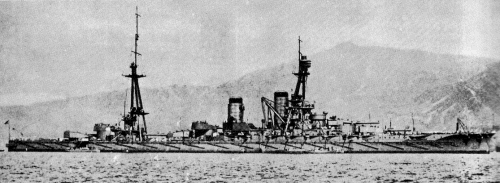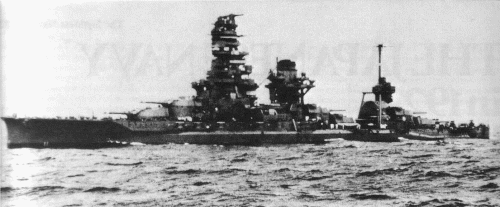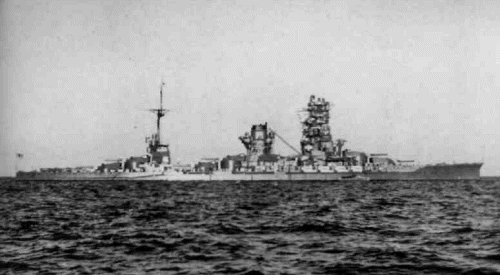

Ise 1918

Hyuga 1941

Ise 1943

Ise 1944
| Name | No | Yard No | Builder | Laid down | Launched | Comp | Fate |
| 伊勢 [Ise] | Kawasaki, Kobe | 10.5.1915 | 12.11.1916 | 15.12.1917 | sunk 28.7.1945 | ||
| 日向 [Hyuga] | 241 | Mitsubishi, Nagasaki | 6.5.1915 | 27.1.1917 | 30.4.1918 | sunk 24.7.1945 |
| Data variant | as completed |
|
Displacement normal, t |
31260 |
|
Displacement full, t |
36500 |
|
Length, m |
205.7 wl 208.2 oa |
|
Breadth, m |
28.7 |
|
Draught, m |
8.80 |
|
No of shafts |
4 |
|
Machinery |
Ise: 4 Curtis steam turbines, 24 Kampon boilers Hyuga: 4 Parsons steam turbines, 24 Kampon boilers |
|
Power, h. p. |
45000 |
|
Max speed, kts |
23 |
|
Fuel, t |
coal 4706 + oil 1411 |
| Endurance, nm(kts) | 9680(14) |
|
Armour, mm |
belt: 305 - 76, deck: 51 - 32, barbettes: 305 - 203, turrets: 305 - 203, casemates: 152, CT: 305 |
|
Armament |
6 x 2 - 356/45 41-shiki, 20 x 1 - 140/50 3-shiki, 6 - 533 TT (beam) |
|
Complement |
1360 |
Project history: Ise and Hyuga were built under the 1912 Programme. Originally it was supposed, that they become repeats of Fuso class, however in the course of designing in drawings the lump of the changes considering both experience of building of battleships of the 1911 Programme, and new requirements of Naval staff has been brought. Other relative positioning of No3 and 4 main gun turrets and boiler rooms amidships became the main difference of new battleships: No3 turret, earlier cramped between two boiler groups, have transferred aft, and all boiler rooms have grouped together, having moved fwd. Both amidships turrets now it was possible to put nearby. The similar arrangement of artillery has simplified a fire control. Use of new calibre of secondary guns (140mm) became other important innovation. Besides shell was lighter and convenient in handling, mounts weighed less, than 152mm ones: that allowed to increase number of secondary guns from 16 to 20.
The scheme of protection has not undergone some significant changes, except for some increase in extent of 305mm part of main belt at the expense of decrease in its thickness at ship ends. Besides, the main armour deck received slopes, adjoining lower edge of main belt. As well as on Fuso, machinery consisted of four turbines with a direct drive and 24 boilers with the mixed fuel, but owing to a little more steam outputs its power was possible to raise from 40000 to 45000hp. It, and also some growth of a hull length (because of boiler rooms redistribution) has led to increase of speed to 23.5kts. Despite all innovations standard displacement has increased all on 600t.
As well as their predecessors, it was supposed after "8-8" program fulfilment to delete Ise and Hyuga from a fleet list, but decisions of the Washington conference of 1922 have changed these plans.
Ship protection: 3.8m-high main belt extended from No1 to No6 barbettes and had 305mm thickness between barbettes, tapering to 102mm at lower edge. It closed by same bulkheads abreast end barbettes. Hull outside end barbettes was protected by 203mm belt tapered to 102mm at lower edge, thickness of this belt decreased to 76mm near ship ends. Upper 203mm belt extended from main belt to upper deck and from No1 to No6 barbette. It was closed by 152mm bulkheads. Casemates had 152mm armor. Main 32mm deck connected with lower edge of main belt by 51mm slopes. Outside barbettes it was flat and its thickness increased to 51mm (76mm over steering gear). Upper deck between end barbettes had 35mm thickness. Forecastle deck over casemates was 19mm. Turrets had 305mm faces, 203mm sides and 114mm crowns. Fore CT had 305mm sides and aft CT had 102mm.
Ship protection after 1936-1937 modernization: 3.8m-high main belt extended from No1 to No6 barbettes and had 305mm thickness between barbettes, tapering to 102mm at lower edge. It closed by same bulkheads abreast end barbettes. Hull outside end barbettes was protected by 203mm belt tapered to 102mm at lower edge, thickness of this belt decreased to 76mm near ship ends. Upper 203mm belt extended from main belt to upper deck and from No1 to No6 barbette. It was closed by 152mm bulkheads. Casemates had 152mm armor. Main 32mm deck connected with lower edge of main belt by 51mm slopes and with upper edge by additional 57mm flat part. Between barbettes its thickness was 97mm over magazines and machinery. Outside barbettes it was flat and its thickness was 51mm (76mm over steering gear). Upper deck between end barbettes had 51mm thickness. Forecastle deck over casemates was 19mm. Funnel uptake had 229mm protection. Turrets had 305mm faces, 203mm sides and 114mm crowns. Fore CT had 305mm sides and aft CT had 102mm.
Ship protection after 1943 modernization: 3.8m-high main belt extended from No1 to No6 barbettes and had 305mm thickness between barbettes, tapering to 102mm at lower edge. It closed by same bulkheads abreast end barbettes. Hull outside end barbettes was protected by 203mm belt tapered to 102mm at lower edge, thickness of this belt decreased to 76mm near ship ends. Upper 203mm belt extended from main belt to upper deck and from No1 to No6 barbette. It was closed by 152mm bulkheads. Casemates had 152mm armor. Main 32mm deck connected with lower edge of main belt by 51mm slopes and with upper edge by additional 57mm flat part. Between barbettes its thickness was 97mm over magazines and machinery. Outside barbettes it was flat and its thickness was 51mm (76mm over steering gear). Upper deck between end barbettes had 51mm thickness. Forecastle deck over casemates was 19mm. Flight deck was protected by 200mm concrete layer. Steering gear had additional 1000mm vertical and 150mm horizontal concrete protection. Funnel uptake had 229mm armor. Turrets had 305mm faces, 203mm sides and 114mm crowns. Fore CT had 305mm sides and aft CT had 102mm
Modernizations: 1921, both: + 4 x 1 - 76/40 3-shiki AA
1931, both: superstructure was reconstructed; + flying-off platform, 3 seaplanes, main guns maximal elevation angle was increased from 25° to 30°.
1933, both: - flying-off platform; + 1 catapult.
(11/1934 - 9.1936, Kure K K) Hyuga; (8/1935 - 3.1937, Kure K K) Ise: hull was lengthened, bulges were fitted, horizontal protection was strengthened. Funnel uptake was protected by 229mm armor. Fully new machinery was fitted. Main guns elevation angle was increased to 43°. Superstructure was reconstructed again, fore funnel was removed. - 4 x 1 - 140/50, 4 x 1 - 76/40, 6 - 533 TT; + 4 x 2 - 127/40 89-shiki, 4 x 1 - 40/62 "HI" 91-shiki, some 13.2/76 MGs.
1937, both: - 4 x 1 - 40/62, 13.2/76 MGs; + 10 x 2 - 25/60 96-shiki. Data was as given in the table.
| Data variant | 1937 modernization |
|
Displacement standard, t |
Ise: 35800 Hyuga: 36000 |
|
Displacement full, t |
Ise: 39657 Hyuga: 40169 |
|
Length, m |
213.4 wl 215.8 oa |
|
Breadth, m |
31.7 |
|
Draught, m |
9.21 |
|
No of shafts |
4 |
|
Machinery |
4 sets Kampon geared steam turbines, 8 Kampon boilers |
|
Power, h. p. |
80000 |
|
Max speed, kts |
25.3 |
|
Fuel, t |
oil 5313 |
|
Endurance, nm(kts) |
7870(16) |
|
Armour, mm |
belt: 305 - 76, bulkheads: 305 - 102, main deck: 97, upper deck: 51, barbettes: 305, turrets: 305 - 114, casemates: 152, CT: 305 |
|
Armament |
6 x 2 - 356/45 41-shiki, 16 x 1 - 140/50 3-shiki, 4 x 2 - 127/40 89-shiki, 10 x 2 - 25/60 96-shiki, 1 catapult, 3 seaplanes (E7K2) |
|
Complement |
1376 |
5/1942, Hyuga: - 1 x 2 - 356/45 (No 5); + 4 x 3 - 25/60 96-shiki, 2-shiki 2-go radar (temporarily for tests)
5/1942, Ise: + 1-shiki 2-go radar
(2 - 8.1943, Kure K K) Ise; (5 - 11.1943, Sasebo K K) Hyuga: were converted to battleships - aircraft carriers. Data was as given in the table. (fd - 1,170 m², ha - 780 m² / 4,680 m³) 1943: Flight deck: 60.0 x 28.0 m. Hangar: 40.0 x 28.0 x 6.00 m. There were 1 lift in center line (6t) and 2 25m catapults.
| Data variant | 1943 modernization |
|
Displacement standard, t |
35350 |
|
Displacement full, t |
38676 |
|
Length, m |
213.4 wl 219.6 oa |
|
Breadth, m |
31.7 |
|
Draught, m |
9.03 |
|
No of shafts |
4 |
|
Machinery |
4 sets Kampon geared steam turbines, 8 Kampon boilers |
|
Power, h. p. |
80000 |
|
Max speed, kts |
25.3 |
|
Fuel, t |
oil 4249 |
|
Endurance, nm(kts) |
7870(16) |
|
Armour, mm |
belt: 305 - 76, bulkheads: 305 - 102, main deck: 97, upper deck: 51, barbettes: 305, turrets: 305 - 114, casemates: 152, CT: 305 |
|
Armament |
4 x 2 - 356/45 41-shiki, 8 x 2 - 127/40 89-shiki, 19 x 3 - 25/60 96-shiki, 2 catapults, 22 seaplanes (8 - 14 D4Y, 8 - 14 E16A) |
| Electronic equipment | 1-shiki 2-go, 2x 2-shiki 2-go radars |
|
Complement |
1463 |
early 1944, Hyuga: + 11 x 1 - 25/60 96-shiki
5/1944, Hyuga: + 8 x 3 - 25/60 96-shiki
6/1944, Ise: + 12 x 3 - 25/60 96-shiki, 11 x 1 - 25/60 96-shiki
9/1944, both: + 6 x 28 - 120 AA RL
11/1944, both: - 2 catapults
Aircraft facilities after 1943 (fd - 1,170 m², ha - 780 m² / 4,680 m³) 1943: Flight deck: 60.0 x 28.0 m. Hangar: 40.0 x 28.0 x 6.00 m. There were 1 lift in center line (6t) and 2 25m catapults.
Naval service: During battle in Leyte Gulf 25.10.1944 both ships have received easy damages: Ise from numerous near misses, Hyuga from a direct bomb hit to an aft end. Both ships since February, 1945 based in Kure, ensuring base air defence. Ise on March, 13th and Hyuga on March, 19th are damaged by American carrier aircraft and then were not under repair any more. On July, 24th they were again damaged by American carrier aircraft, Hyuga ran aground by aft end. During raid on July, 28th both battleships have received new bomb hits. Ise was sunk on shallow water by F4U fighters from US carrier Hancock (18 direct hits of 454kg bombs and many near misses). She was salvaged in 1946 - 1947 and scrapped. Hyuga took 10 direct hits of 454kg bombs from diving bombers SB2C from US carrier Ticonderoga, abandoned, sunk on shallow water, salvaged in 1946 - 1947 and scrapped.

Ise 1918

Ise 1937

Hyuga

Ise
Many thanks to Wolfgang Stöhr for additional information on this page.
© Ivan Gogin, 2008-14